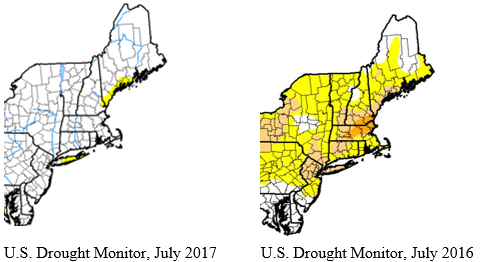For Immediate Release
July 26, 2017
Contact: John Bott, 207-287-3156, john.c.bott@maine.gov
Robert
G. Marvinney, Ph.D., 207-287-2804
Tom Gordon, M.P.A., 207-287- 4986
Summer Water
Resources Update
2017 conditions are
better, according to state geologist and agriculture officials
AUGUSTA
- Department of Agriculture, Conservation and Forestry (DACF) officials have
provided a summer 2017 Maine water resources overview. Compared to the summer
of 2016, Maine is positioned much better this summer in terms of water
resources.
Normal
winter conditions in the early part of 2016, plus normal precipitation in the
spring, contributed to near normal runoff and recharge to groundwater. As of
July 18, in all of New England, only a small area of southern coastal Maine was
experiencing abnormally dry conditions according to the U.S. Drought Monitor.
For
comparison, in July of 2016 most of New England was under abnormally dry to
moderate drought conditions and some areas of Massachusetts were in severe
drought.

In Maine last year, the southern coastal part of the state was hit particularly hard with moderate to severe drought through the summer months.
Groundwater experienced excellent recharge during Spring 2017 with most observation wells in the U.S. Geological Survey’s monitoring network reaching slightly above normal levels. Current conditions are near normal across the state, with only a few wells in southwestern Maine experiencing slightly below normal conditions. “This shows great improvement over 2016 when most wells in the southern half of the state were far below normal,” said State Geologist Robert Marvinney. “It’s good news for public water systems, irrigators, and other users of Maine’s groundwater.”
Stream flows in July 2017 are currently near normal in the western part of the state and slightly below normal in the east, compared to 2016 when most gaging stations showed well below normal flows.
Tom Gordon, of the DACF’s Soil and Water Program, stressed
that, while this is good news for farmers, the time to prepare for the next drought
is now. “While drought conditions have abated, land owners need to plan and
prepare their water infrastructure for the next drought,” said Gordon. “Information
on agricultural water management can be found on the Department’s website at: http://www.maine.gov/dacf/ard/water_management/index.shtml.”
###
|